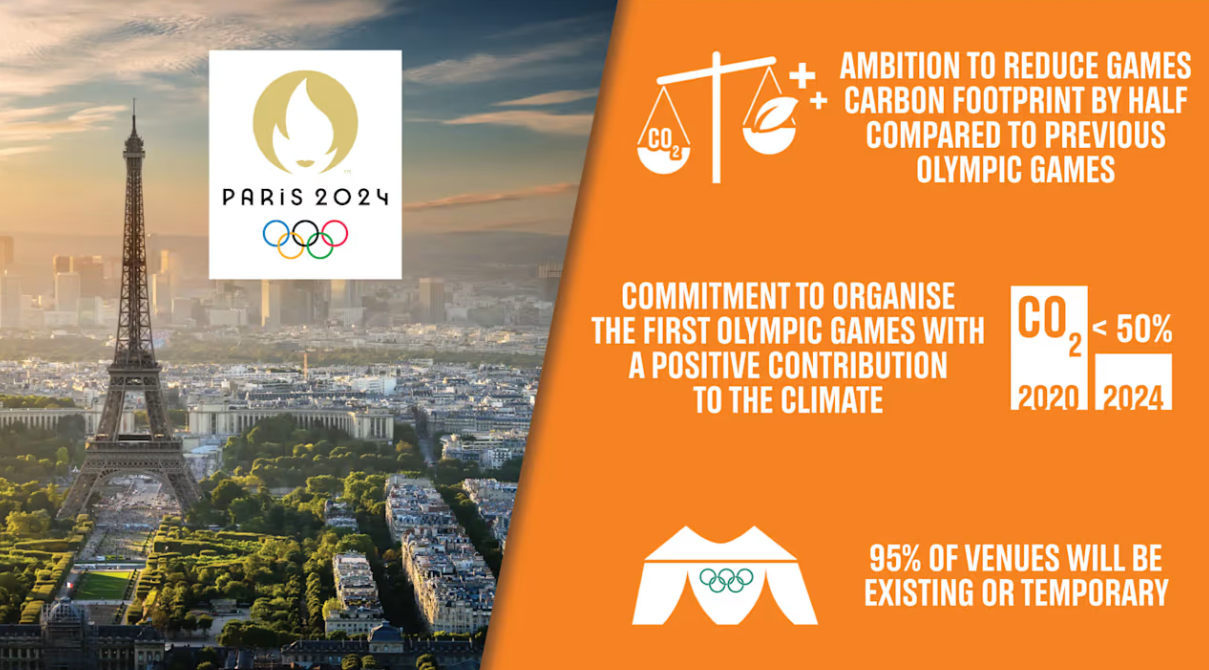Paris 2024 Olympics and Sustainability: Greenest Olympics Ever?
The Paris 2024 Olympic Games, which is now underway, has been celebrated as the “greenest” and most sustainable Olympics in history. Organizers have pledged to cut the carbon footprint by 50 percent compared to previous Games while implementing innovative solutions for energy, food, venues, transport and digital services. This is in line with IOC’s Sustainability Strategy, which covers five inter-related focus areas (infrastructure and natural sites, sourcing and resource management, mobility, workforce, and climate), and its 2020+5 Olympic Agenda. From utilizing renewable energy in all venues to deploying recyclable beds in the Village, the Paris Games can credibly claim the title of “greenest Games” but we have to wait for the final verdict. Scroll below to find out how.
EDITOR’S NOTE: The articles below were curated by TBG Purpose, our corporate sustainability division. When we’re not watching Olympians achieve incredible feats in the swimming pool, running track or gymnasium, we help companies of all sizes to achieve their corporate sustainability and ESG goals. For more information, just send us an email.
Courtesy: IOC
Less, better and for longer: Five ways Paris 2024 is delivering more sustainable Games (Olympics.com)
1. Thinking ahead: anticipating and avoiding impact
Already at the candidature phase, Paris 2024 committed to reducing the Games carbon footprint by half compared to previous editions. A carbon budget was set which includes all Games planning and operations - from construction to energy and transport, catering and procurement.
Targeting a 50 per cent reduction in carbon emissions compared to the average of London 2012 and Rio 2016, Paris 2024 has addressed the broadest category of emissions, also covering the indirect footprint of the Games (scope 3 emissions) such as spectator travel. This means that Paris 2024 will offer the first Olympic Games aligned with the Paris Agreement on Climate Change, adopted in 2015.
Paris 2024 also proactively calculated its "material footprint" – a first in the history of the Olympic and Paralympic Games. Venue by venue, the organisers created a detailed map of required resources, aiming to minimise them and control their life cycle before, during and after the Games. From spectator seating to tents, beds, chairs, tables and even tennis balls – every asset has been meticulously planned.
The Paris 2024 organisers have also avoided generating carbon emissions thanks to an innovative energy model. In addition to using 100 per cent renewable energy during the Games, Paris 2024 is minimising the use of diesel generators. The few generators that will have to be used will be powered by biofuel, H2 or batteries. All venues will be connected to the grid to avoid the use of temporary energy solutions.
In addition, Paris 2024 developed a unique methodology for analysing and reducing the Games’ impact on biodiversity and translated this into the design of more sustainable temporary venues.
2. Reducing, renting and reusing
Integrated into every level of the organisation, Paris 2024’s circular economy strategy is based on three key principles: organising the Games with fewer resources, making better use of these resources and ensuring the second life of resources after the Games - before the event even starts.
A total of 95 per cent of the Paris 2024 competition venues will be pre-existing or temporary. The rest have been built using low-carbon construction methods.
The Aquatics Centre –is designed to serve the local Seine-Saint-Denis community long after the Games. The Centre will largely rely on energy provided by 4,680 square metres of solar panels installed on its rooftop. All seats in the Centre are made from recycled local plastic waste. Wood is at the heart of the building, helping to reduce emissions from construction.
The principle of reduction also applies to the interior design of the venues. Tents, chairs, computers and sports equipment - Paris 2024 has reduced and encouraged shared use whenever possible. This approach has made it possible, for example, to reduce the amount of furniture needed for the Games from the initially estimated 800,000 items to 600,000.
Out of two million pieces of sports equipment, three-quarters will be rented or provided by sports federations. More than three-quarters of the electronic equipment such as screens, computers and printers are also rented. The same is true for all the stands, tents and bungalows.
Thanks to their innovative sourcing strategy, the organisers confirm that 90 per cent of the six million assets will be taken back and reused by partners and the organisers are now defining the second-life plan for the remaining 10 per cent of goods.
Click here to continue the article.





Courtesy: Olympics.com
'Greenest in history': How Paris aims to halve the Olympics' carbon footprint (France 24)
The 2024 Paris Olympic and Paralympic Games are being hailed as the “greenest” in history by organisers.
Tony Estanguet, president of the organising committee for Paris 2024, has said the Games will be "historic for the climate", a sentiment echoed by all those involved, notably Paris’s ecologically-minded Mayor Anne Hildago.
The stated aim is to reduce by more than half the carbon emitted by London 2012 and Rio 2016 – which emitted 3.4 million and 3.6 million tonnes of CO2, respectively – to under 1.5 million tonnes of CO2. This is less than Tokyo 2021, which emitted 1.9 million tonnes of CO2 despite being deprived of spectators due to the Covid-19 pandemic.
"We want to show that another model is possible and create a legacy for major sporting events. We don't claim to be perfect, but we want to show that we can do things differently," says Georgina Grenon, the environmental excellence director for Paris 2024.
In previous Games, the carbon footprint was calculated after the event wrapped up. By calculating the emissions of policy decisions before they are made and implemented, Paris has taken a different approach.
The carbon budget is divided into three distinct categories: travel (34%), construction (33%) and operations (catering, accommodation, logistics, etc. – 33%). "This dynamic is the right one, and the stated objective seems to be in line with the Paris Agreement," says Maël Besson, a specialist in environmental issues relating to sport.
Paris’s ability to use existing infrastructure for events is also driving down emissions relative to the Games’ predecessors.
Nearly all (95%) of the Olympic venues have already been built. Athletics will take place at the Stade de France (in Seine-Saint-Denis, just outside Paris city limits), cycling at the Saint-Quentin-en-Yvelines velodrome (Yvelines), basketball at Bercy, fencing at the Grand Palais; the Champ de Mars Arena will host judo and wheelchair rugby.
his strategy contrasts strongly with previous Games such as Athens 2004, where costly and since-abandoned "white elephant" sites still haunt the city’s politicians.
Paris claims to be cutting edge when it comes to construction, too. Grenon says the objective is not to exceed 700kg of CO2 emissions per square metre built, compared with…”
Click here to continue the article.
Courtesy: Paris 2024/Olympics.com
‘Greenest ever Games’: how the Paris Olympics hopes to inspire a new era of global sporting events (The Guardian)
Beneath the undulating wooden roof of the Paris Olympics’ new aquatics centre, the architect Laure Mériaud hoped the groundbreaking low carbon building would bring a kind of calm to the intersection of motorways near the Stade de France stadium in the Paris suburb of Saint-Denis.
“It’s not just about technical innovation,” she said. “It’s about creating a more pleasant, greener space for local people’s daily lives here after the Games.”
The organisers of the Paris Olympics – which begin in July – have vowed they will be the “greenest ever Games”, halving the carbon footprint of London 2012 and Rio 2016 from their average of 3.5m tonnes of CO2 to about 1.75m tonnes.
Mostly using existing stadiums instead of embarking on the giant Olympic building projects of the past, making athletes’ bedside tables from recycled badminton shuttlecocks and providing dinner plates without logos which can be repurposed after the Games, the Paris committee has said it is setting a precedent for cleaner global sporting events.
But environmental analysts warn that the very act of holding a planetary sporting event like the Olympics has to be completely reconsidered if the world is to reach net zero targets in 2050. In future, the sporting events could be spread over various locations instead of the current model of millions of spectators flying to one city, they suggest.
“The single most important decision we have made is not to build,” said Georgina Grenon, environmental excellence director for Paris 2024. Unlike the major building projects of the Rio, London and Tokyo games, 95% of the sites that will be used in Paris are existing venues or temporary structures. The new-build projects include the aquatics centre and the athletes’ village in the low-income département of Seine-Saint-Denis north of Paris. “The second most important decision was to…”
Click here to continue the article.
Courtesy: Olympics.com
Timber venues, river swimming and re-use: how the Paris Olympics is going green – and what it’s missing (The Conversation)
As Paris prepares to host the Olympic and Paralympic Games, the sustainability of the event is coming under scrutiny.
The organisers have promoted Paris 2024 as the greenest Olympics ever, aiming to halve the carbon emissions of previous Olympics. They have drastically cut back on building new stadiums and venues, and have relied heavily on wood as a building material for new infrastructure and used low-carbon concrete. This approach has another benefit: it’s cheaper.
But hosting the world’s biggest sporting event, with thousands of athletes and millions of spectators, will still come at an environmental cost.
This has led to calls for a radical rethink of the Olympic Games, including for it to be scaled back. But longer term, Paris 2024’s sustainability efforts may create a lasting legacy for the city – and for future games.
The vision for Paris 2024 is simple: “do more with less, do better and leave a useful legacy”.
These Games will be the first to align with the sustainability-focused New Norm plan outlined by the International Olympics Committee.
Hosting the Olympics is a huge undertaking. Previous Olympics have seen host cities spend billions on new stadiums and competition venues. But once the competition is over, many of these expensive buildings are little used – or even abandoned.
It’s also carbon intensive. Paris organisers intend to halve the emissions of London 2012 and Rio 2016, but even so, these games will add an estimated two million tonnes of carbon dioxide to the atmosphere – the same as the annual emissions of a small country like Malta or the Bahamas. Paris won’t have the…
Click here to continue the article.
Courtesy: Olympics.com




